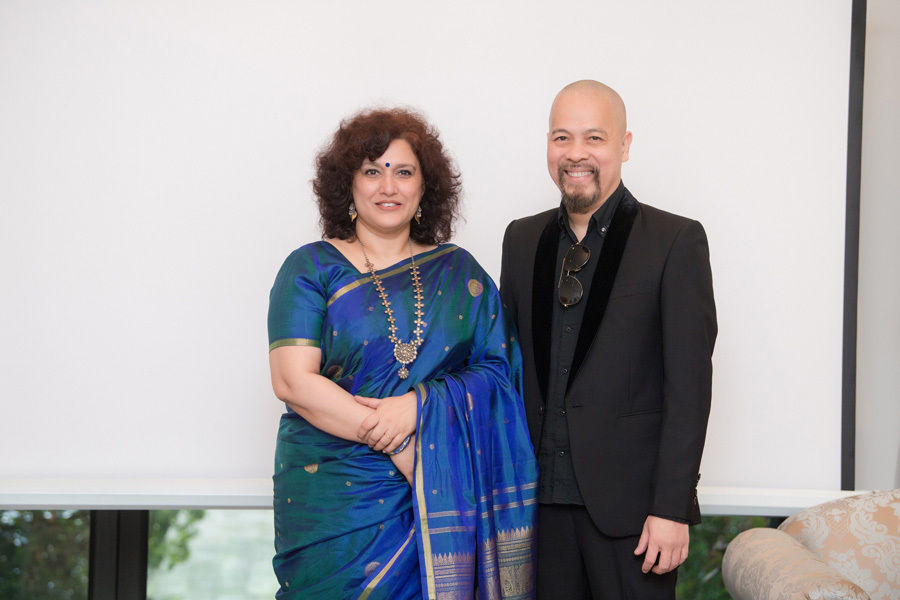Vietnam, India traditional costumes show similarities
Experts believe that centuries-long cultures have nurtured traditional costumes of Vietnam and India.
A mini show dedicated to the beauty of both Vietnamese and Indian women’s traditional costumes has left a great impression on attendants thanks to their vitality formed and lasted through different periods of the centuries-long culture of each country.
| Vietnamese and Indian women in traditional dress at the seminar on Oct 18. Photo: Thu Hoai |
The most striking features of the costumes like Vietnamese Ao Dai and Indian Saree, Lehenga Choli, and Salwar kameez are appearances and patterns, it's values that are forged over the centuries, as intangible cultural heritage and the pride of each nation.
More similarities of the costumes were shared at the seminar titled “Preserving Culture of Vietnam and India: Traditional Women’s Costumes” held by the Vietnam-India Friendship Association of Hanoi (HAVIFA) and Swami Vivekananda Culture Center, Embassy of India in Hanoi on Oct 18
“The way Vietnamese women decorate their dresses and scarves is unique, imbued with indigenous culture, quite similar to those in Indian costumes, especially our Northeast,” said Manu Verma, spouse of Indian Ambassador to Vietnam Pranay Verma.
Traditional clothing evokes the hidden strength within a woman. Sometimes it reflects women’s sense of responsibility, their ability to take care of the family, the virtue of sacrifice, the ingenuity, and the charm, Manu Verma said at the event marking the participation of spouses of Vietnam’s Deputy Foreign Minister Nguyen Quoc Dung and Vietnamese Ambassador to India Nguyen Thanh Hai, HAVIFA’s Chairwoman Phan Lan Tu, Designer Duc Hung, deputy director of the Thang Long Water Puppet Theater, and Miss Vietnam 2010 Ngoc Han.
Traditional costumes seem like “identification” of each woman, reflecting the cultural beauty of each country, and the imprints of the historical periods.
Manu Verma said she was impressed when seeing a collection of Vietnamese women’s traditional costumes. It showed interesting similarities in female traditional dresses in Vietnam and India.
She made an interesting comparison that in Indian history, their queens wore saree to the battle while Hai Ba Trung (Trung Sisters) also put on their traditional costumes fighting the enemy. These elephant-riding warrior sisters have since become heroic icons to Vietnamese people all over the world.
In her talks, she expressed her special impression of Ao Dai. Manu Verma shared that she was hesitant to wear Ao Dai as she was not slim enough. However, Miss Vietnam Ngoc Han gifted her a dress so nice that it fit her well. The confidence helped her to wear Ao Dai at an event held in the Van Mieu (Temple of Literature) in 2019.
“When looking at the mirror, I appear to be more charming and I think that traditional clothing fits everyone,” Manu Verma exclaimed.
Sharing the same idea, Rachna Srivastav, Acting Director of the Swami Vivekananda Cultural Center (SVCC), First Secretary (Consular), Embassy of India in Hanoi, said the traditional costumes play an important role in the culture of each country. For Vietnam and India, they are part of the long-lasting tradition and the development journey.| Manu Verma, spouse of Indian Ambassador to Vietnam Pranay Verma and Vietnamese Designer Duc Hung. Photo: Hoang Vu |
Designer Duc Hung said Indian traditional costumes somewhat convey the centuries-long history of the nation and he felt the spiritual aspect in the clothing. It’s wonderful that they keep popularity until now, among people, especially young ones.
Hung said that Vietnam’s Ao Dai has experienced centuries of changing with more charming and comfort as it’s nowadays.
He said it’s interesting that Ao Dai has combined the versions in all three parts Northern, Central, and Southern regions of Vietnam, incorporating the local traits to make it popular and charming.
The designer, who is also a meritorious artist bestowed by the state, shared that Ao Dai is his endless inspiration. Many Vietnamese designers, including him, have brought Ao Dai collections to international fashion shows namely the New York Fashion Week, Paris Fashion Week, Milan Fashion Week, London Fashion Week, and Russia Fashion Week.
In addition, Vietnamese candidates in international beauty pageants have impressed the world by the beauty of Vietnam’s traditional dress. Expressing the role of Ao Dai in Vietnam’s tradition and in the world’s fashion landscape, Hung said he feels like lyrics in a song by famous musician Thanh Tung “If you catch a glimpse of Ao Dai flying on the street, you will see the soul of the homeland there.”
Hung said Ao Dai has gained identity in the world’s fashion map and he’s proud to contribute to the honor of Ao Dai. Hung shared that he officially focused on designing Ao Dai in 2007 when he designed costumes for Dang Minh Thu who won runner-up Miss World Vietnamese 2007.
Miss Vietnam Ngoc Han said the visit to India three years ago has inspired her to design a collection of Ao Dai with some hidden combinations from Indian women’s traditional costumes or spiritual values from Indian culture.
The collection has brought the two cultures closer and helped the people-to-people links more effectively, Han said.
Held in the 91st year of the Vietnamese Women’s Day, the seminar is aimed to enhance the friendship and mutual understanding of people in the two countries, mostly on the occasion of the 75th anniversary of the Indian Independence Day and the 76th anniversary of Vietnam’s National Day.
On this occasion, HAVIFA held an online photo contest honoring Ao Dai and Saree. The event gained the participation of many organizations, including the Indian community in Vietnam.
| Indian and Vietnamese women, including Miss Vietnam Ngoc Han (3rd left) in traditional costumes at the event. Photo: Thu Hoai |

.jpg)

.jpg)










